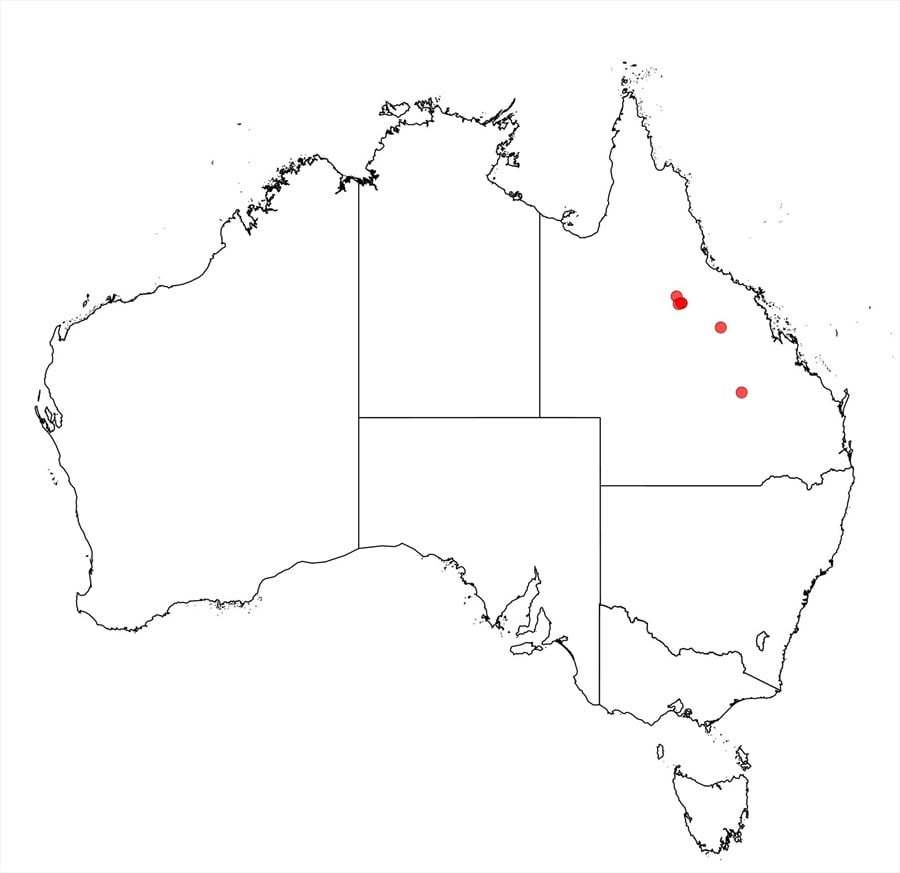Acacia faucium Pedley
WATTLE
Acacias of Australia
Family
Fabaceae
Distribution
Common in the headwaters of Torrens Ck in White Mountains, Qld, where it occurs in sandstone gorges. It also occurs in broken country farther S, c. 100 km N of Clermont.
Description
Tree 3–10 m high. Branchlets acutely angled or sometimes flattened towards apices, soon terete, glabrous but minutely appressed hairy on young plants. Phyllodes straight to shallowly (occasionally obviously) falcate, often ±dimidiate, (9–) 12–18 cm long, (15–) 20–30 mm wide, thinly coriaceous, glabrous but sparsely appressed-hairy on young plants; with numerous, parallel longitudinal nerves rather crowded (normally 3–6 per mm), 2 or 3 nerves more prominent than the rest and confluent with each other towards the base, anastomoses few to relatively numerous; pulvinus 3–6 mm long, yellowish to greyish brown when dry; gland basal, prominent. Inflorescences simple; peduncles (3–) 4–5 mm long, glabrous; spikes 35–60 mm long, flowers subdense to subdistant. Flowers 5-merous; calyx gamosepalous, rather broad, usually with a few spreading hyaline hairs towards base. Pods linear, crustaceous, to c. 8 cm long, 3–4 mm wide, straight to curved or sometimes openly coiled, rounded and longitudinally wrinkled over seeds, glabrous, dark brown, somewhat pruinose at least when young, marginal nerves thick and yellowish. Seeds longitudinal, pale brown, 3.5–4 mm long; aril cupular.
Specimens
Qld: “Warang” Holding, White Mounains, 37 km NNW of Torrens Creek township, D.G.Fell DF1303 & M.R.Swain (BRI); 88 km NE of Clermont on Clermont–Mackay road, T.J.McDonald 556 (BRI); 3 mi.[c. 5 km] NE of ‘New Twin Hills’ H.S., L.Pedley 1738 (BRI).
Notes
Acacia faucium is member of the taxonomically complex ‘A. cunninghamii group’ (see A. concurrens). It is closely related to A. leiocalyx but, according to L.Pedley (loc.cit.), has usually longer, more chartaceous phyllodes with more widely spaced secondary nerves, shorter spikes, usually a few hairs on the calyx and valves of the pod cartilaginous.
FOA Reference
Data derived from Flora of Australia Volumes 11A (2001), 11B (2001) and 12 (1998), products of ABRS, ©Commonwealth of Australia
Author
B.R.Maslin
This identification key and fact sheets are available as a mobile application:
URL: https://apps.lucidcentral.org/wattle/
© Copyright 2018. All rights reserved.







